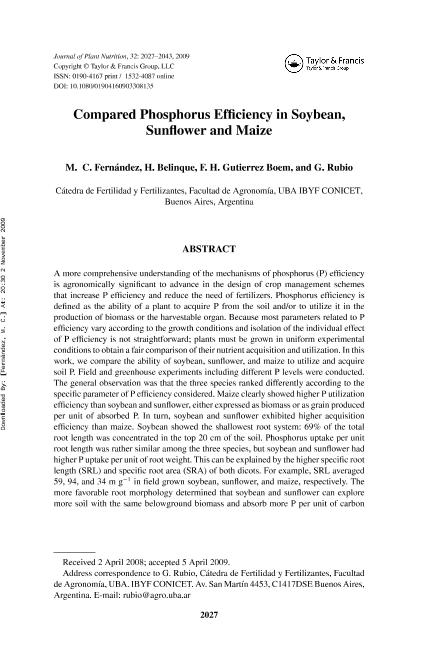Mostrar el registro sencillo del ítem
dc.contributor.author
Fernández, M.C.
dc.contributor.author
Belinque, H
dc.contributor.author
Gutiérrez Boem, Flavio Hernán

dc.contributor.author
Rubio, Gerardo

dc.date.available
2018-09-26T18:01:39Z
dc.date.issued
2009-12
dc.identifier.citation
Fernández, M.C.; Belinque, H; Gutiérrez Boem, Flavio Hernán; Rubio, Gerardo; Compared phosphorus efficiency in soybean, sunflower and maize; Taylor ; Journal of Plant Nutrition; 32; 12; 12-2009; 2027-2043
dc.identifier.issn
0190-4167
dc.identifier.uri
http://hdl.handle.net/11336/60918
dc.description.abstract
A more comprehensive understanding of the mechanisms of phosphorus (P) efficiency is agronomically significant to advance in the design of crop management schemes that increase P efficiency and reduce the need of fertilizers. Phosphorus efficiency is defined as the ability of a plant to acquire P from the soil and/or to utilize it in the production of biomass or the harvestable organ. Because most parameters related to P efficiency vary according to the growth conditions and isolation of the individual effect of P efficiency is not straightforward; plants must be grown in uniform experimental conditions to obtain a fair comparison of their nutrient acquisition and utilization. In this work, we compare the ability of soybean, sunflower, and maize to utilize and acquire soil P. Field and greenhouse experiments including different P levels were conducted. The general observation was that the three species ranked differently according to the specific parameter of P efficiency considered. Maize clearly showed higher P utilization efficiency than soybean and sunflower, either expressed as biomass or as grain produced per unit of absorbed P. In turn, soybean and sunflower exhibited higher acquisition efficiency than maize. Soybean showed the shallowest root system: 69% of the total root length was concentrated in the top 20 cm of the soil. Phosphorus uptake per unit root length was rather similar among the three species, but soybean and sunflower had higher P uptake per unit of root weight. This can be explained by the higher specific root length (SRL) and specific root area (SRA) of both dicots. For example, SRL averaged 59, 94, and 34 m g-1 in field grown soybean, sunflower, and maize, respectively. The more favorable root morphology determined that soybean and sunflower can explore more soil with the same belowground biomass and absorb more P per unit of carbon invested below ground. Since the three species exhibited similar values of P uptake per unit root length, we hypothesize that the capacity of each segment of root to deplete soil P fractions is similar. © Taylor & Francis Group, LLC.
dc.format
application/pdf
dc.language.iso
eng
dc.publisher
Taylor

dc.rights
info:eu-repo/semantics/openAccess
dc.rights.uri
https://creativecommons.org/licenses/by-nc-sa/2.5/ar/
dc.subject
Field Experiment
dc.subject
Nutrient Uptake
dc.subject
Pampean Region
dc.subject
Roots
dc.subject.classification
Agricultura

dc.subject.classification
Agricultura, Silvicultura y Pesca

dc.subject.classification
CIENCIAS AGRÍCOLAS

dc.title
Compared phosphorus efficiency in soybean, sunflower and maize
dc.type
info:eu-repo/semantics/article
dc.type
info:ar-repo/semantics/artículo
dc.type
info:eu-repo/semantics/publishedVersion
dc.date.updated
2018-09-21T20:35:33Z
dc.journal.volume
32
dc.journal.number
12
dc.journal.pagination
2027-2043
dc.journal.pais
Países Bajos

dc.journal.ciudad
Londres
dc.description.fil
Fil: Fernández, M.C.. Consejo Nacional de Investigaciones Científicas y Técnicas. Instituto de Invetigaciones Bioquímicas y Fisiologicas; Argentina. Universidad de Buenos Aires. Facultad de Agronomía. Departamento de Ingeniería Agrícola y Uso de la Tierra. Cátedra de Fertilidad y Fertilizantes; Argentina
dc.description.fil
Fil: Belinque, H. Consejo Nacional de Investigaciones Científicas y Técnicas. Instituto de Invetigaciones Bioquímicas y Fisiologicas; Argentina. Universidad de Buenos Aires. Facultad de Agronomía. Departamento de Ingeniería Agrícola y Uso de la Tierra. Cátedra de Fertilidad y Fertilizantes; Argentina
dc.description.fil
Fil: Gutiérrez Boem, Flavio Hernán. Consejo Nacional de Investigaciones Científicas y Técnicas. Instituto de Invetigaciones Bioquímicas y Fisiologicas; Argentina. Universidad de Buenos Aires. Facultad de Agronomía. Departamento de Ingeniería Agrícola y Uso de la Tierra. Cátedra de Fertilidad y Fertilizantes; Argentina
dc.description.fil
Fil: Rubio, Gerardo. Consejo Nacional de Investigaciones Científicas y Técnicas. Instituto de Invetigaciones Bioquímicas y Fisiologicas; Argentina. Universidad de Buenos Aires. Facultad de Agronomía. Departamento de Ingeniería Agrícola y Uso de la Tierra. Cátedra de Fertilidad y Fertilizantes; Argentina
dc.journal.title
Journal of Plant Nutrition

dc.relation.alternativeid
info:eu-repo/semantics/altIdentifier/doi/https://dx.doi.org/10.1080/01904160903308135
dc.relation.alternativeid
info:eu-repo/semantics/altIdentifier/url/https://www.tandfonline.com/doi/abs/10.1080/01904160903308135
Archivos asociados
